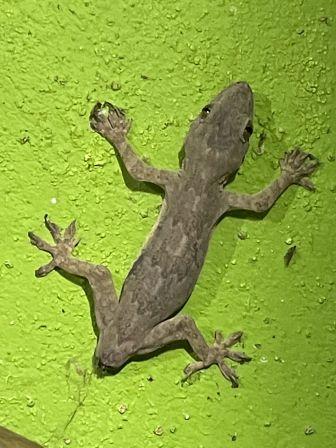| From lighting fires using stones and sticks to travelling to distant planets; Human Race has come a long way in its evolutionary journey. But as we look at the stars and beyond; there are still several simple natural phenomena that remain unsolved. But every time we come across such a phenomenon, scientists try and study, decode and imitate nature to help solve humanity's biggest challenges. American Science Writer, Janine Benyus, sums up this process in a single line… “What if, every time I started to invent something, I asked, ‘How would nature solve this?’” Building on this mantra, Prof. Animangsu Ghatak - Professor with the Department of Chemical Engineering at the Indian Institute of Technology, Kanpur, has been part of one such project, where an inquiry into Lizard’s ability to climb the wall and break off its tail at will, has answered several key questions and paved the way for the development of new technologies. The discovery will find several applications in robotics, stealth technology, prosthetics, design of load-bearing components and many other domains. In an exclusive interview with JagranJosh.com, Prof. Ghatak shares some key insights about this discovery and the impact it might have on our lives. Excerpts from the InterviewQuestion 1: Welcome to JagranJosh.com, Prof Ghatak. Thanks for taking the time to speak with us and Congratulations for being featured in The New York Times and invited by The Science Magazine for a commentary on the ‘Paradox of the Lizard Tail’.Answer. Thanks for having me. Question 2: What is Autonomy and How do Plants and Animal use it as a Survival Tool?Answer: Many animals self-amputate their body part or an appendage, like legs, chelipeds, antennae, tails, even skin to elude their attacker. Lizards, salamanders, spiders, octopuses, mice and worms all employ such strategy. This particular defence trait of sacrificing a limb when under threat is called autotomy. In most cases, the animal can regenerate their lost limb almost perfectly or completely perfectly. Yet there are species that do not care to regenerate their lost limb. Although autotomy is prevalent in animals, some plant species have been found to employ this defence mechanism. For example, Oxalis pes-caprae, an invasive plant found in South Africa have developed a notch at the base of the stem of their leaves and flowers. When the plant is pulled by herbivores, the leaf or the flower breaks away leaving the whole plant intact; so, the plant survives. Question 3: Please explain anti-predatory behaviour and its evolution in different Animal Groups?Answer: As I mentioned in the previous paragraph, many animals shed their body part to evade capture by their predators, the ease with which the animal can do it depends on the specific anatomy of the joint that keeps this limb connected to the body. Autotomy involves cost as it reduces the physical fitness of the animal to locomote and to forage, its mating success and importantly its ability to defend against a future attack by a predator. Therefore, the animal has to ensure that autotomy occurs only when it is absolutely necessary and not otherwise. Importantly, the bonding of the limb with the animal has to be just right that it does not shed off during its regular activity nor it should be so difficult that it loses that precious moment, while struggling to release itself from the grasp of its predator. Question 4: What is the Paradox of the Lizard Tail?Answer: So, the lizard, and for that matter all animals that resort to autotomy, has to meet this conflicting demand: strong attachment of the limb with its main torso, yet easy and rapid shedding whenever required. That is the paradox about the Lizard tail that the author of the Science article attempted to address. Question 5: Please describe, how were you involved in solving Paradox of the Lizard Tail?Answer: The authors of the main research article (the one written by Baban et al) published in the same issue of Science (in which my article was published) showed that autotomy of lizard tail occurs via adhesion failure mediated by hierarchical micro-structures at fracture planes in their tail (details presented later). By carrying out detailed experiments they unravelled different mechanisms of adhesion that allow these animals to shed their tail when required.
In my own research at IIT Kanpur, I have explored quite extensively different physical principles, particularly sub-surface phenomena that can affect adhesion at the surface of an adhesive. These mechanisms are employed by different wall climbing organisms like insects, geckos, frogs to adhere reversibly to different surfaces in their habitat. So, the editor of Science invited me to write a commentary on Baban et al’s article and give a broad perspective of this topic that will be of interest to general audience and to non-experts. Question 6: What exactly is meant by reversible adhesion?By reversible adhesion, I mean the ability of these animals to adhere strongly, yet to walk or dart on variety of surfaces, sometimes vertically upside down, even while carrying a payload. The adhesive thus allows strong adhesion yet easy release and remains also usable over many times in the life cycle of these animals. Question 7: Why and How are Lizards able to perform Self-Amputation as part of their natural Biological Process?Answer: Lizard has intravertebral fracture planes at its tail portion. In essence there exists a distinct unossified plane within the vertebrae in the tail portion of these animals. These are weak zones where fracture can occur and expectedly it can’t take much load. Researchers have carried out proteomic studies of the liquid that oozes out after the tail breaks away to show that there is no evidence of any bond breakage. In other word, the tissue at the tail does not get ruptured during its shedding. Therefore, the authors of the Science article examined the fractured surfaces of the tail under scanning electron microscope (SEM) and discovered that there are hierarchical micro-structures at these surfaces the dimension of which ranges from few micrometers to tens of nano-meters. They found that the broken surface of tail consists of microscopic mushroom like structures which themselves remain decorated with nanoscopic holes and nanobeads. The mushroom head remains in close attachment with the broken surface of the main body of the animal, without any mechanical interlocking but via forces of adhesion. They made also model adherents of rubber like materials to show that adhesion can be strong enough to keep the limb bonded to its body. From the point of view of bio-mechanics, when the tail is pulled along the length of the lizard body, adhesion via millions of mushroom heads help in distribution of the pulling load over a large area so crack does not initiate. As a result, during normal activity of the animal, the tail does not break away. However, when a predator grabs it, the lizard does the bending or twisting action, because of which, the bending load gets concentrated at one side of its torso leading to initiation and catastrophic propagation of the crack. Question 8: Can you please share some practical use cases of this discovery in real-life situations?Answer: Many engineering devices, particularly in robotics, stealth technology, prosthetics, design of load bearing components, an optimized-link similar to the one present at the lizard tail can be useful in saving an otherwise expensive equipment or device from catastrophic failure. Besides that, biologists are interested in studying autotomy as a part of their research on regeneration of a lost limb. For example, if we have cut on our skin, our body can heal it. Or say, if the bone fractures, we can regenerate it. But if there is loss of limb, say a finger, we can not get it back. Question 9. How exactly does the hierarchy help in this process?Answer: Hierarchical micro-structure result in flexibility, discontinuity of contact and spatial variation in deformability of the adhesive layer, all of which lead to significant enhancement in adhesion via crack trapping, crack deflection and multiple crack initiation mechanism. Question 10. Beside Autotomy what other mechanisms are employed by organisms in self-defence?Answer: Autotomy is one among many strategies that organisms have evolved to escape capture by their predators. Some of them are inherent or permanent to the behaviour of the organism like nocturnal activity, hiding and camouflaging to avoid detection. Yet autotomy and several others like spraying hot and toxic chemicals to oozing out bad odor, to generating, borrowing and storing toxic chemicals in its body are resorted to when the animal encounters a hostile predator. Question 11. Why should one be interested in studying a phenomenon like “Autotomy”?Answer: Animals have evolved through millions of years and have developed their survival strategy. The engineering principles that they have developed are robust, elegant, efficient and optimized for multi-functionality. They say “the tiniest insect is more complex than a star”. Almost all engineering and scientific fields of research can enrich themselves by learning different behaviour of organisms and by mimicking those principles. “Autotomy” is one of the most prominent defence mechanisms in large class of animals, even in some plants and therefore it is of interest for us to know how exactly these animals accomplish it. Questions 12. Which organizations funded your research?Answer: Over the years I have been generously funded by different government agencies like DST, SERB, CSIR, ICMR and some industries like UNILEVER and PORTESCAP India Limited. |
About the Expert
Prof Ghatak’s research interests include studying different aspects of soft material and interfaces like adhesion, friction, fracture, surface wettability and instabilities. His work has been published in top international journals like Science, Proceedings of National Academy of Science, Advanced Materials, Physical Review Letters and others. |

 Prof. Animangsu Ghatak is faculty at the Indian Institute of Technology Kanpur. He completed his B.Tech. and M.Tech. in Chemical Engineering from IIT Kharagpur and IIT Kanpur respectively. Following this, he completed his PhD from Lehigh University, PA, USA. Thereafter, he carried out post-doctoral research at Cambridge University, UK and Harvard University, USA. After returning to India, he joined IITK in the Chemical Engineering Department in 2004 and has been there since.
Prof. Animangsu Ghatak is faculty at the Indian Institute of Technology Kanpur. He completed his B.Tech. and M.Tech. in Chemical Engineering from IIT Kharagpur and IIT Kanpur respectively. Following this, he completed his PhD from Lehigh University, PA, USA. Thereafter, he carried out post-doctoral research at Cambridge University, UK and Harvard University, USA. After returning to India, he joined IITK in the Chemical Engineering Department in 2004 and has been there since.
Comments
All Comments (0)
Join the conversation